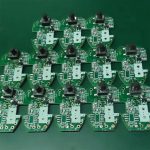What is a Resistive Touch Sensor?
A resistive touch sensor is a type of touch-sensitive interface that detects touch input by measuring the change in electrical resistance between two conductive layers when they are pressed together. It consists of a sandwich of layers, including a flexible top layer and a rigid bottom layer, separated by a thin space. When a user touches the screen, the two layers make contact, and the sensor detects the change in resistance at the point of contact.
Key Components of a Resistive Touch Sensor
A typical resistive touch sensor consists of the following components:
- Top Layer: A flexible, transparent polyester film coated with a conductive material, usually indium tin oxide (ITO).
- Bottom Layer: A rigid, transparent substrate, such as glass or acrylic, also coated with a conductive material (ITO).
- Spacer Dots: Tiny, transparent insulating dots placed between the top and bottom layers to maintain a small gap between them when not touched.
- Conductive Bars: Conductive bars or electrodes are placed along the edges of the top and bottom layers to apply a uniform voltage gradient across the conductive surfaces.
- Controller: An electronic controller that applies voltage, measures resistance changes, and calculates the touch coordinates.
How Does a Resistive Touch Sensor Work?
The working principle of a resistive touch sensor is based on the change in electrical resistance between the two conductive layers when they are pressed together. Here’s a step-by-step explanation of how it works:
- Voltage Application: The controller applies a voltage gradient across the conductive bars on the top and bottom layers, creating a uniform voltage distribution across the conductive surfaces.
- Touch Input: When a user touches the screen with a finger or stylus, the flexible top layer deforms and makes contact with the bottom layer at the point of touch.
- Resistance Change: As the two conductive layers touch, the electrical resistance at the point of contact changes, allowing current to flow between the layers.
- Coordinate Detection: The controller measures the voltage drop across the conductive bars on the top and bottom layers, calculating the X and Y coordinates of the touch point based on the resistance ratios.
- Touch Data Output: The controller sends the touch coordinates to the host device, which interprets the data and performs the appropriate action or function.
Voltage Divider Principle
The coordinate detection in a resistive touch sensor relies on the voltage divider principle. When the top and bottom layers make contact, they form a voltage divider circuit, with the resistance between the contact point and the conductive bars determining the voltage drop across each layer.
The controller measures the voltage ratios along the X and Y axes to calculate the touch coordinates using the following equations:
X = (Vx / Vref) × Width
Y = (Vy / Vref) × Height
Where:
– Vx and Vy are the measured voltages along the X and Y axes, respectively.
– Vref is the reference voltage applied to the conductive bars.
– Width and Height are the dimensions of the touch sensor.
Advantages of Resistive Touch Sensors
Resistive touch sensors offer several advantages that make them popular in various applications:
- Cost-effective: Resistive touch sensors are generally less expensive to manufacture compared to other touch technologies, making them a cost-effective solution for many devices.
- Durability: With a flexible top layer and a rigid bottom layer, resistive touch sensors are more durable and resistant to scratches and impacts than other touch technologies.
- High Accuracy: Resistive touch sensors provide high touch accuracy, enabling precise touch input for applications that require detailed control or input.
- Pressure Sensitivity: Unlike capacitive touch sensors, resistive touch sensors can detect the amount of pressure applied during a touch, allowing for pressure-sensitive functionality in some applications.
- Stylus and Glove Support: Resistive touch sensors can be operated with any object that applies pressure, including gloved fingers and passive styluses, making them suitable for environments where capacitive touch may not be practical.

Disadvantages of Resistive Touch Sensors
Despite their advantages, resistive touch sensors also have some limitations:
- Multi-touch Limitations: Most resistive touch sensors only support single-touch input, as the controller cannot distinguish between multiple simultaneous touch points. Some advanced resistive touch sensors offer limited multi-touch capabilities, but they are not as sophisticated as capacitive multi-touch sensors.
- Reduced Optical Clarity: The multiple layers in a resistive touch sensor, including the flexible top layer and the air gap, can reduce the optical clarity of the display beneath the sensor, affecting the overall image quality.
- Wear and Tear: The flexible top layer of a resistive touch sensor is subject to wear and tear over time, especially with frequent use. This can lead to reduced sensitivity and accuracy, or even complete failure of the touch functionality.
- Reduced Sensitivity: Resistive touch sensors require a certain amount of pressure to activate, which can result in reduced sensitivity compared to capacitive touch sensors. This may affect the user experience in applications that require light or quick touch input.
Applications of Resistive Touch Sensors
Resistive touch sensors find applications in a wide range of devices and industries, including:
- Smartphones and Tablets: Although capacitive touch sensors have largely replaced resistive sensors in high-end smartphones and tablets, some budget-friendly devices still use resistive touch technology.
- Industrial Control Panels: Resistive touch sensors are commonly used in industrial control panels, where their durability, accuracy, and ability to work with gloves make them a preferred choice.
- Medical Devices: Many medical devices, such as patient monitors and diagnostic equipment, use resistive touch sensors for their reliability and ease of use with gloved hands.
- Automotive Displays: Resistive touch sensors are used in some automotive displays, particularly in older vehicle models or budget-friendly infotainment systems.
- Point-of-Sale (POS) Systems: Resistive touch sensors are often used in POS systems, such as cash registers and self-service kiosks, due to their cost-effectiveness and compatibility with various input methods.
Frequently Asked Questions (FAQ)
-
Q: Can resistive touch sensors work with any type of stylus?
A: Yes, resistive touch sensors can work with any object that applies pressure, including passive styluses, fingers, or even gloved hands. They do not require a specialized or active stylus like some capacitive touch sensors. -
Q: How do resistive touch sensors compare to capacitive touch sensors in terms of cost?
A: Resistive touch sensors are generally less expensive to manufacture than capacitive touch sensors, making them a more cost-effective solution for many applications. However, the cost difference has decreased over time as capacitive touch technology has become more widespread. -
Q: Are resistive touch sensors suitable for outdoor use?
A: Yes, resistive touch sensors can be used in outdoor environments, as they are not affected by moisture, dust, or changes in temperature. However, direct exposure to water or extreme weather conditions may still pose challenges. -
Q: Can resistive touch sensors detect multiple touch points simultaneously?
A: Most resistive touch sensors only support single-touch input, as the controller cannot distinguish between multiple simultaneous touch points. Some advanced resistive touch sensors offer limited multi-touch capabilities, but they are not as sophisticated as capacitive multi-touch sensors. -
Q: What is the typical lifespan of a resistive touch sensor?
A: The lifespan of a resistive touch sensor depends on various factors, such as the quality of the materials used, the frequency of use, and the operating environment. On average, a well-designed resistive touch sensor can last for several years with proper care and maintenance. However, the flexible top layer is subject to wear and tear over time, which can eventually lead to reduced sensitivity or complete failure of the touch functionality.
Conclusion
Resistive touch sensors have been a reliable and cost-effective touch sensing solution for many years, finding applications in various devices and industries. By understanding their working principles, advantages, and limitations, engineers and designers can make informed decisions when choosing the most suitable touch technology for their projects.
As technology advances, resistive touch sensors continue to evolve, with improvements in durability, sensitivity, and multi-touch capabilities. However, they face increasing competition from capacitive touch sensors, which offer superior multi-touch performance and a more seamless user experience.
Ultimately, the choice between resistive and capacitive touch sensors depends on the specific requirements of the application, such as cost, durability, accuracy, and environmental factors. By weighing these factors and considering the unique advantages of each technology, developers can create touch-enabled devices that meet the needs of their users and deliver a superior touch experience.
| Feature | Resistive Touch Sensor | Capacitive Touch Sensor |
|---|---|---|
| Cost | Lower | Higher |
| Durability | High | Moderate |
| Accuracy | High | High |
| Multi-touch Support | Limited | Extensive |
| Pressure Sensitivity | Yes | No |
| Stylus and Glove Support | Yes | Limited |
| Optical Clarity | Reduced | High |
| Sensitivity | Reduced | High |
Table 1: Comparison of key features between resistive and capacitive touch sensors.
In summary, resistive touch sensors remain a vital technology in the world of touch-sensitive interfaces, offering a balance of cost-effectiveness, durability, and accuracy. As the touch industry continues to evolve, it is essential for professionals to stay informed about the latest advancements and trends in touch sensing technologies, enabling them to make the best decisions for their projects and deliver innovative, user-friendly touch experiences.






Leave a Reply